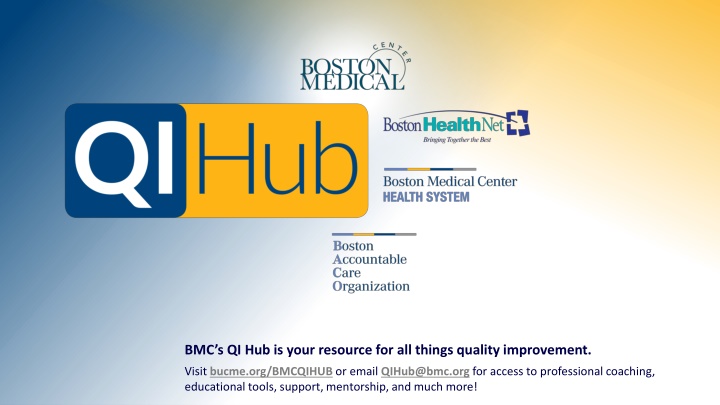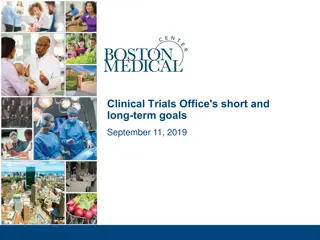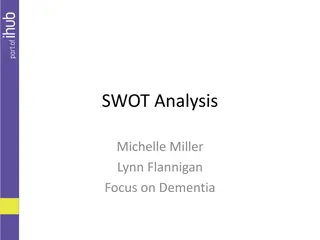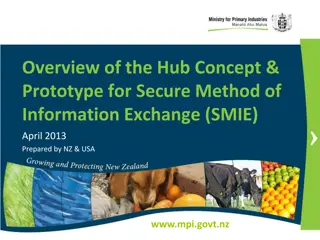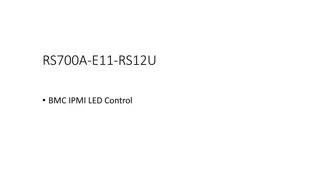BMC's Quality Improvement Hub: Your Go-To Resource for Quality Enhancement
BMC's QI Hub offers professional coaching, educational tools, support, mentorship, and more for quality improvement. Learn about setting aims, establishing measures, selecting changes, testing and implementing change effectively for improved outcomes. Understand the components of a good aim statement and differentiate between useful and not-so-useful aims. Take the pop quiz to assess your understanding of improving patient safety in healthcare practices.
Download Presentation

Please find below an Image/Link to download the presentation.
The content on the website is provided AS IS for your information and personal use only. It may not be sold, licensed, or shared on other websites without obtaining consent from the author.If you encounter any issues during the download, it is possible that the publisher has removed the file from their server.
You are allowed to download the files provided on this website for personal or commercial use, subject to the condition that they are used lawfully. All files are the property of their respective owners.
The content on the website is provided AS IS for your information and personal use only. It may not be sold, licensed, or shared on other websites without obtaining consent from the author.
E N D
Presentation Transcript
BMCs QI Hub is your resource for all things quality improvement. Visit bucme.org/BMCQIHUB or email QIHub@bmc.org for access to professional coaching, educational tools, support, mentorship, and much more!
Aims and Measures Leading Change Collaborative 2021 October 18, 2021
Model for Improvement Setting Aims Establishing Measures Selecting Changes Testing Change Implementing Change
Setting an Aim What are you trying to accomplish?
Defining an Aim A system, organization, individual won t improve without a clear and firm intention to do so The first thing needed is an aim statement
Components of an Aim Statement It is specific, measurable and addresses these points: What outcome are you trying to improve? How good? By when? For whom (or for what system)? Should be succinct and not contain extraneous background information
Examples of Good Aim Statements I will lose 25 pounds by April 18, 2022 My football team will raise $10,000 for charity by July 4, 2022 All of these aims are specific about measure, time, and population. (how good, by when, and for whom) They tell us exactly where we re going and what we expect to accomplish
Not So Useful Aims I will lose weight. We will raise money. How good? By when? Who knows. We could try forever and never get there, because it s not clear where there is. Hot takes: We will reduce the time to antibiotics for MICU patients with sepsis by 25% by June 30, 2022. We will increase the percent of MICU patients with sepsis that were administered antibiotics within 60 minutes by 10% by June 30, 2022. We will decrease mortality in MICU patients with sepsis from 23% to 18% by June 30, 2022.
POP QUIZ We aim to improve patient safety in our GIM ambulatory practices. a) Good b) Bad c) Ugly By Jan 1 of 2021, we will reduce the incidence of pressure ulcers in the critical care unit by 50 percent. a) Good b) Bad c) Ugly We will reduce all types of hospital-acquired infections. a) Good b) Bad c) Ugly
Measurement Framework How will we know that a change is an improvement?
Why Measure? Measurement is a critical part of testing and implementing changes Measures tell a team whether the changes being made are actually leading to improvement.
Family of Measures For any improvement project, you ll want to identify a FAMILY of measures, which consists of: 1.Outcome Measure 2.Process Measure 3.Balancing Measure Each kind of measure will give you important information about how the changes you are making are affecting the system.
Outcome Measure Where are you ultimately trying to go? These are the measures you want to move at the end of the day Although it can be, your outcome measure doesn t need to be a B-HAG Big Hairy Audacious Goal (e.g. mortality, 30-day readmissions, etc.)
Process Measure Are we doing the right things to get there? To affect outcomes, you have to improve the processes Measuring the process changes will tell you if the parts/steps in the system are performing as predicted
Balancing Measure Are the changes hurting other parts of the system? Measures to see if changes designed to improve one part of the system are causing new problems in other parts of the system
Example #1 Decrease the time to antibiotics in critically ill MICU patients from 70 minutes to 45 minutes by April 1, 2022 Steps Taken: 1. You created a matching ED quick list and inpatient order set with appropriate antibiotics for each possible site of infection 2. You ensured the broad spectrum antibiotic for each infection site is stored in the Pyxis machine on each floor But are those changes leading to improvement? You can only know if you have a measurement framework
Family of Measures - Example #1 Outcome Measure Time to first dose of the broad spectrum antibiotic (minutes) Process Measures Percent of first dose broad spectrum antibiotics ordered from the ED quick list or inpatient order set Time from Pyxis removal to administration (minutes) Balancing Measure Percent of Pyxis stock outs among all broad spectrum antibiotics
Example #2 The aim in your group is to decrease the % of patients with COPD who are readmitted to the hospital within 30 days from 18% to 15% by April 1, 2022. Steps Taken: 1. You created a new consult service to improve transitions of care for COPD patients 2. You set up home services for those at high risk of readmissions 3. You created a patient education curriculum for nursing But are those changes leading to improvement? You can only know if you have a measurement framework
Family of Measures - Example #2 Outcome Measure 30-day readmission rate for COPD patients Process Measures % of discharge follow up visits occurring within 7 days of discharge OR time to follow-up appointment (measured in days) % of patients with severe COPD receiving home services upon discharge Balancing Measure Length of stay for COPD admissions
POP QUIZ AIM: Reduce the incidence of ventilator-associated pneumonia in the ICU by 20 percent by June 1, 2021. # of extubated patients requiring reintubation within 24 hours a) Outcome b) Process c) Balancing Percent of patients with ventilator-associated pneumonia a) Outcome b) Process c) Balancing Average number of days on mechanical ventilation a) Outcome b) Process c) Balancing
Tips for effective measures Remember: Data will be plotted over time Improvement requires change, and change is, by definition, a temporal phenomenon Seek usefulness not perfection Measurement is not the goal; improvement is the goal Integrate measure into the daily routine Useful data are often easy to obtain without relying on IT systems SMART Goals: Specific, Measurable, Achievable, Relevant, Timely
BREAKOUT! You ll be placed into different breakout groups Using the Data Measurement Plan Worksheet Define an aim related to your project Start to think through a family of measures for your project
